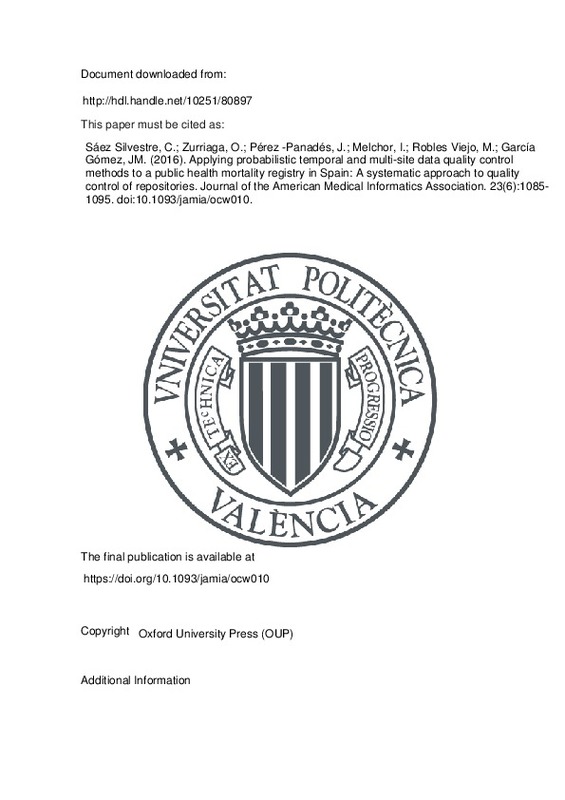JavaScript is disabled for your browser. Some features of this site may not work without it.
Buscar en RiuNet
Listar
Mi cuenta
Estadísticas
Ayuda RiuNet
Admin. UPV
Applying probabilistic temporal and multi-site data quality control methods to a public health mortality registry in Spain: A systematic approach to quality control of repositories
Mostrar el registro sencillo del ítem
Ficheros en el ítem
| dc.contributor.author | Sáez Silvestre, Carlos
|
es_ES |
| dc.contributor.author | Zurriaga, Oscar
|
es_ES |
| dc.contributor.author | Pérez-Panadés, Jordi
|
es_ES |
| dc.contributor.author | Melchor, Inma
|
es_ES |
| dc.contributor.author | Robles Viejo, Montserrat
|
es_ES |
| dc.contributor.author | García Gómez, Juan Miguel
|
es_ES |
| dc.date.accessioned | 2017-05-11T08:46:41Z | |
| dc.date.available | 2017-05-11T08:46:41Z | |
| dc.date.issued | 2016-04-23 | |
| dc.identifier.issn | 1067-5027 | |
| dc.identifier.uri | http://hdl.handle.net/10251/80897 | |
| dc.description.abstract | OBJECTIVE: To assess the variability in data distributions among data sources and over time through a case study of a large multisite repository as a systematic approach to data quality (DQ). MATERIALS AND METHODS: Novel probabilistic DQ control methods based on information theory and geometry are applied to the Public Health Mortality Registry of the Region of Valencia, Spain, with 512 143 entries from 2000 to 2012, disaggregated into 24 health departments. The methods provide DQ metrics and exploratory visualizations for (1) assessing the variability among multiple sources and (2) monitoring and exploring changes with time. The methods are suited to big data and multitype, multivariate, and multimodal data. RESULTS: The repository was partitioned into 2 probabilistically separated temporal subgroups following a change in the Spanish National Death Certificate in 2009. Punctual temporal anomalies were noticed due to a punctual increment in the missing data, along with outlying and clustered health departments due to differences in populations or in practices. DISCUSSION: Changes in protocols, differences in populations, biased practices, or other systematic DQ problems affected data variability. Even if semantic and integration aspects are addressed in data sharing infrastructures, probabilistic variability may still be present. Solutions include fixing or excluding data and analyzing different sites or time periods separately. A systematic approach to assessing temporal and multisite variability is proposed. CONCLUSION: Multisite and temporal variability in data distributions affects DQ, hindering data reuse, and an assessment of such variability should be a part of systematic DQ procedures. | es_ES |
| dc.description.sponsorship | This work was supported by the Spanish Ministry of Economy and Competitiveness grant numbers RTC-2014-1530-1 and TIN-2013-43457-R, and by the Universitat Politecnica de Valencia grant number SP20141432. | en_EN |
| dc.language | Inglés | es_ES |
| dc.publisher | Oxford University Press (OUP) | es_ES |
| dc.relation.ispartof | Journal of the American Medical Informatics Association | es_ES |
| dc.rights | Reserva de todos los derechos | es_ES |
| dc.subject | data mining | es_ES |
| dc.subject | data monitoring | es_ES |
| dc.subject | data quality | es_ES |
| dc.subject | data reuse | es_ES |
| dc.subject | multisite repositories | es_ES |
| dc.subject | statistical data analysis | es_ES |
| dc.subject.classification | ESTADISTICA E INVESTIGACION OPERATIVA | es_ES |
| dc.subject.classification | FISICA APLICADA | es_ES |
| dc.title | Applying probabilistic temporal and multi-site data quality control methods to a public health mortality registry in Spain: A systematic approach to quality control of repositories | es_ES |
| dc.type | Artículo | es_ES |
| dc.identifier.doi | 10.1093/jamia/ocw010 | |
| dc.relation.projectID | info:eu-repo/grantAgreement/MINECO//RTC-2014-1530-1Q4618002BC.VALENCIANA/ES/Servicio de evaluación y rating de la calidad de repositorios de datos biomédicos/ | es_ES |
| dc.relation.projectID | info:eu-repo/grantAgreement/EC/H2020/692023/EU/Linking excellence in biomedical knowledge and computational intelligence research for personalized management of CVD within PHC/ | |
| dc.relation.projectID | info:eu-repo/grantAgreement/UPV//SP20141432/ | es_ES |
| dc.relation.projectID | info:eu-repo/grantAgreement/MINECO//TIN2013-43457-R/ES/CARACTERIZACION DE FIRMAS BIOLOGICAS DE GLIOBLASTOMAS MEDIANTE MODELOS NO-SUPERVISADOS DE PREDICCION ESTRUCTURADA BASADOS EN BIOMARCADORES DE IMAGEN/ | |
| dc.rights.accessRights | Abierto | es_ES |
| dc.contributor.affiliation | Universitat Politècnica de València. Escuela Técnica Superior de Ingenieros Industriales - Escola Tècnica Superior d'Enginyers Industrials | es_ES |
| dc.contributor.affiliation | Universitat Politècnica de València. Escola Tècnica Superior d'Enginyeria Informàtica | es_ES |
| dc.description.bibliographicCitation | Sáez Silvestre, C.; Zurriaga, O.; Pérez-Panadés, J.; Melchor, I.; Robles Viejo, M.; García Gómez, JM. (2016). Applying probabilistic temporal and multi-site data quality control methods to a public health mortality registry in Spain: A systematic approach to quality control of repositories. Journal of the American Medical Informatics Association. 23(6):1085-1095. https://doi.org/10.1093/jamia/ocw010 | es_ES |
| dc.description.accrualMethod | S | es_ES |
| dc.relation.publisherversion | https://doi.org/10.1093/jamia/ocw010 | es_ES |
| dc.description.upvformatpinicio | 1085 | es_ES |
| dc.description.upvformatpfin | 1095 | es_ES |
| dc.type.version | info:eu-repo/semantics/publishedVersion | es_ES |
| dc.description.volume | 23 | es_ES |
| dc.description.issue | 6 | es_ES |
| dc.relation.senia | 307797 | es_ES |
| dc.identifier.eissn | 1527-974X | |
| dc.identifier.pmid | 27107447 | |
| dc.contributor.funder | Universitat Politècnica de València | es_ES |
| dc.contributor.funder | Ministerio de Economía y Competitividad | es_ES |







![[Cerrado]](/themes/UPV/images/candado.png)

